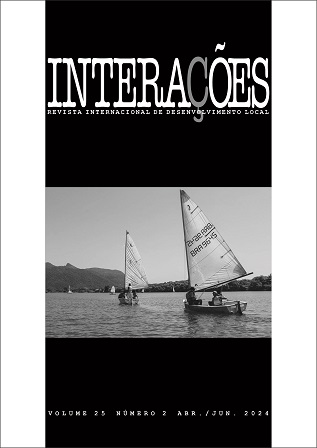The Party of St. Benedict from rua da Barra in Rosario Oeste, MT
Keywords:
Cultural Practice, Feast of São Benedito, Rosario Oeste, Regional developmentAbstract
This article has as its object the party of St. Benedict from Rua da Barra in Rosario Oeste, MT. It aims to analyze its history, its ritual and the devotion of the party, considering the need for records of this cultural event of a religious nature, which has been happening for over 100 years and had not yet been researched as a cultural practice. The theoretical framework, guiding the analysis of empirical data, was based on the categories of culture (Alves, 2021) and religious festival (Queiroz, 1976; Claval, 2007). Data were collected through primary sources, in semi-structured interviews with descendants of the Oliveira party family and people who experience or have experienced the party. A documentary survey was also carried out, complemented by images of the event. Data obtained through secondary sources were sought in written works such as books, articles, book chapters, magazines, theses and dissertations by authors who address the subject. The Festa de São Benedito da Rua da Barra is an event of devotion and faith, which was born in the Oliveira family, in the rural area of the city, and, nowadays, it is an event of great magnitude, visited by the inhabitants of Rosario and other cities of the state. However, the continuation of the festival as a tradition with its current characteristics is not auspicious, considering that customs change at the whim of transformations in social relations. And, as the transformations are continuous, it will be necessary to adjust the party to the ongoing transformations.
References
DIZARÓ, Paula. Adoração, devoção e veneração: existe diferença? Portal Canção Nova, Cachoeira Paulista, 2006. Disponível em: https://formacao.cancaonova.com/igreja/doutrina/adoracao-devocao-e-veneracao-existe-diferenca/. Acesso em: 3 maio 2022.
ALVES, Gilberto Luiz. Arte, artesanato e desenvolvimento regional: temas sul-mato-grossenses. Campo Grande, MS: Ed. UFMS, 2014. 103p.
ALVES, Gilberto Luiz. Cultura e singularidades culturais. Curitiba: CRV, 2021. 104 p.
CLAVAL, Paul. A geografia cultural. 3. ed. Florianópolis: Ed. da UFSC, 2007. 453 p.
FERRAZ, Ana Maria Borges. Caderno de folclore mato-grossense, n. 2. Cururu: Prefeitura Municipal de Cuiabá; Secretaria Municipal de Cultura e Turismo, 1990. 97 p.
FLORES. Maria Bernadete Ramos. Oktoberfest: turismo, festa e cultura na estação do chopp. Florianópolis, SC: Letras contemporâneas, 1997. 188 p.
GRANDO, Beleni Saléte. Cultura e dança em Mato Grosso: catira, curussé, folia de reis, siriri, cururu, São Gonçalo, rasqueado e dança cabocla. Cuiabá, MT: Central de texto; Cáceres, MT: UNEMAT Editora, 2005. 87 p.
HOBSBAWN, Eric. A invenção das tradições. In. HOBSBAWN, Eric; RANGER, Terence (Org.). A invenção das tradições. 6. ed. São Paulo: Editora Paz e terra S.A., 2008. 316p. p. 9–24.
LOUREIRO, Roberto. Cultura Mato-Grossense: festas de santos e outras tradições. Cuiabá, MT: Entrelinhas, 2006. 239p.
MOREIRA, Ana Cristina de Lima. Religiosidade popular: devoção e cultura. Nossa Senhora do Perpétuo Socorro: padroeira da Serra da Mandioca em Palmeira dos Índios – Alagoas. 2. ed. Maceió: Editora Olyver, 2019. 134p.
OLIVEIRA, Pedro Ribeiro. Catolicismo popular e mudança social. Religiosidade Popular, (suplemento), Petrópolis, n. 12, p. 3–11, set. 1985.
QUEIROZ, Maria Isaura Pereira de. O campesinato brasileiro: ensaios sobre civilização e grupos rústicos no Brasil. Petrópolis: Vozes, 1976. 242 p.
PAULA E SILVA, Dom Francisco de. Vida de São Benedito, o preto. Machado, MG: Gráfica Editora Folha Machadense, 2002. 75 p.
SOUZA, Gerson Martins; PEREIRA, Tarcísio José. Cultura popular. Brasília: Projeção, 2014. 144 p.
Downloads
Published
How to Cite
Issue
Section
License
Copyright (c) 2023 Gildete Evangelista da Silva, Rosemary Matias, Gilberto Luiz Alves

This work is licensed under a Creative Commons Attribution 4.0 International License.
Direitos Autorais para artigos publicados nesta revista são do autor, com direitos de primeira publicação para a revista. Em virtude de aparecerem nesta revista de acesso público, os artigos são de uso gratuito, com atribuições próprias, em aplicações educacionais e não-comerciais.


